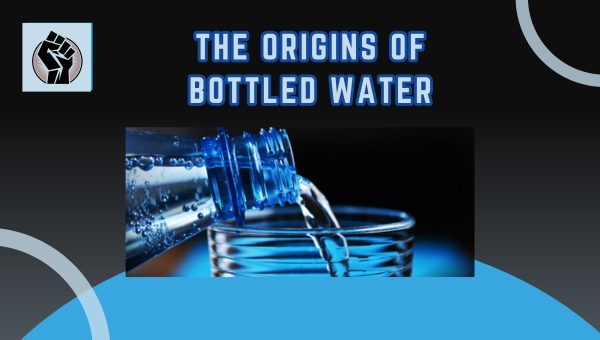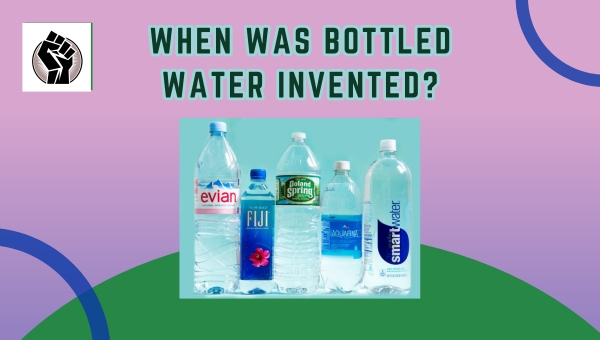It was a time when people relied on rivers or wells for fresh water, carrying it in jars or skins. Then, picture the moment when bottled water became a revolutionary concept, transforming how we access this life-essential resource. The question arises: when was bottled water invented?
This intriguing journey takes us from ancient water storage methods to the birth of commercial bottling, unveiling how modern technology and consumer demand shaped today’s industry. Whether you’re curious about its origins or its evolution into a global phenomenon, this article dives into the captivating history of bottled water. Let’s explore how it all began and where it’s headed.
The Origins Of Bottled Water
The story of bottled water is deeply rooted in the history of humanity’s relationship with water. From primitive techniques for water storage to the sophisticated bottling processes we see today, the journey is fascinating. Let’s explore how early practices shaped the path to commercial bottling.

Early Practices Of Water Storage
Before the idea of bottling water emerged, ancient civilizations relied on various methods to store and transport water. People used natural materials like clay pots, animal skins, and carved gourds to ensure a steady supply of water for daily needs. These vessels were durable and practical, helping communities access water during times of scarcity.
Over time, advancements in craftsmanship led to the creation of more refined containers such as ceramic jars and metal vessels. These innovations not only improved the storage of water but also played a key role in supporting trade and travel. Despite their utility, these methods were primarily about survival rather than convenience or commercialization.
Transition From Storage To Commercial Bottling
The leap from basic water storage to commercial bottling marked a significant turning point in history. With the rise of industrialization in the 18th and 19th centuries, the focus shifted from merely storing water to making it a marketable commodity. This was driven by growing urbanization and the increasing demand for clean drinking water in densely populated areas.
Glass bottles became the preferred medium for packaging water during the early stages of commercial bottling. Their transparency and ability to preserve water quality made them ideal for distributing water over long distances.
This transition also coincided with the rise of health-focused trends, as people began seeking bottled water for its supposed medicinal benefits. Over time, this paved the way for the global industry we recognize today.
Also Read: Surge Beverage: Taste, Nutrition, and Market Insights
When Was Bottled Water Invented?
The concept of bottled water dates back centuries, evolving from a simple necessity to a global industry. It’s fascinating to see how the first attempts at commercializing bottled water paved the way for what we recognize today. Let’s delve into how it all began and the significant moments that shaped its history.

The First Commercial Bottling Efforts
The earliest known commercial bottling of water can be traced back to 1621 in the United Kingdom. At this time, water from the Malvern Hills was bottled and sold for its perceived health benefits. The practice was primarily driven by the belief that natural spring water had medicinal properties. Bottled water was marketed as a luxury item and was often associated with health and wellness.
By the 18th century, more companies started to bottle and distribute mineral water, particularly in Europe. For example, the famous Spa brand hailing from Belgium began bottling water around this time. These early efforts were mostly limited to local markets, with glass bottles being the primary means of storage.
The process was labor-intensive, as bottling technology was still in its infancy. However, these initial ventures laid the groundwork for what would become a booming industry. This period marked the beginning of water moving beyond local consumption to being a product that could be transported and sold.
Key Milestones In Bottled Water History
Over the years, several significant developments shaped the bottled water industry into its modern form.
Let’s break down the key milestones:
- The 19th Century Boom: By the 19th century, bottled water gained momentum, especially in the United States. Saratoga Springs in New York became a prominent name, with its water being bottled and distributed widely.
- Introduction of Plastic Bottles: In the 20th century, the shift from glass to plastic revolutionized the industry. The introduction of polyethylene terephthalate (PET) bottles in the 1970s made water bottles lighter, more affordable, and easier to transport.
- Global Expansion: By the 1980s and 1990s, bottled water brands like Evian and Perrier became household names across the globe, emphasizing purity and health.
- Emergence of Flavored and Enhanced Waters: The late 20th and early 21st centuries saw the rise of flavored and vitamin-enriched waters, catering to diverse consumer tastes and health trends.
These milestones demonstrate how bottled water transitioned from a localized, luxury product to a global commodity accessible to millions. The journey reflects advancements in technology, marketing, and global trade, each playing a crucial role in shaping its history.
The Evolution Of Bottled Water
The journey of bottled water has been shaped by technological advancements and a growing market demand. From its humble beginnings to becoming a global industry, the evolution of bottled water reflects significant changes in production methods and consumer behavior.

Let’s explore the innovations and growth that have defined this transformation.
Innovations In Bottling Technology
Advancements in bottling technology have revolutionized how water is packaged, ensuring better quality, efficiency, and sustainability.
These innovations have played a key role in shaping the industry:
- Introduction of Glass Bottles: In the 18th century, glass bottles were the first materials used for water packaging, offering a durable and reusable solution.
- Advent of Plastic Bottles: The 1960s saw the emergence of polyethylene terephthalate (PET) bottles, which were lightweight, cost-effective, and easier to transport.
- Automation in Production: Modern bottling lines now use automated machinery to clean, fill, and seal bottles with precision, significantly enhancing production speed.
- Eco-friendly Packaging: Recent years have seen the rise of biodegradable and recycled materials, aimed at reducing the environmental impact of bottled water.
Each of these advancements has contributed to making bottled water more accessible while addressing consumer needs for convenience and sustainability.
Growth Of The Bottled Water Industry
The bottled water industry has witnessed remarkable expansion over the decades, transitioning from a niche market to a staple in many households worldwide.
Several factors have driven this growth:
- Increased Demand for Clean Water: In areas where access to safe drinking water is limited, bottled water has become a necessity.
- Health-Conscious Consumers: As more people seek alternatives to sugary beverages, bottled water has emerged as a preferred choice for hydration.
- Global Distribution Networks: The development of efficient transportation and distribution systems has enabled bottled water brands to reach consumers across the globe.
- Brand Diversification: Companies have introduced a variety of options, such as sparkling water, flavored water, and mineral-enriched water, catering to diverse preferences.
This growth not only highlights the adaptability of the industry but also underscores its ability to meet changing consumer expectations. The bottled water market continues to thrive, reflecting its importance in modern lifestyles.
Also Read: Aquafina Water Bottle – The Ultimate Hydration Solution
Bottled Water In The Modern Era
The modern era has witnessed significant changes in the way bottled water is produced, consumed, and perceived. While it remains a convenient option for many, it also brings new challenges and opportunities. Let’s explore two key aspects: environmental concerns and its growing popularity on the global stage.
Environmental Concerns And Sustainability
Environmental issues surrounding bottled water production and disposal have become a major focus.
Here are some key points regarding the challenges and efforts in this area:
- Plastic Waste Crisis: Single-use plastic bottles contribute significantly to global waste, with many ending up in landfills or oceans.
- Carbon Footprint: The production and transportation of bottled water consume energy, leading to increased greenhouse gas emissions.
- Recycling Initiatives: Many organizations are promoting recycling programs to reduce plastic waste and encourage the use of recycled materials in bottle production.
- Alternative Packaging: Companies are exploring sustainable alternatives, such as biodegradable or reusable packaging, to minimize environmental impact.
Popularity And Global Market Trends
The demand for bottled water continues to grow, driven by shifting consumer preferences and expanding markets. The following trends are shaping the industry today:
- Health-Conscious Consumers: More people are choosing bottled water over sugary beverages for health reasons, boosting its popularity.
- Premium Products: The rise of products like mineral and alkaline water has captured the interest of consumers seeking higher-quality options.
- Emerging Markets: Rapid urbanization and limited access to safe drinking water in some regions have fueled bottled water consumption in developing countries.
- Technological Advancements: Smart packaging and digital innovations are enhancing consumer experience and differentiating brands in a competitive market.
Each of these factors reflects the dynamic nature of bottled water in today’s world, shaping its role in modern society.
FAQs
When was bottled water invented?
Bottled water was first commercially produced in the 1760s in the United Kingdom. It marked the beginning of water being packaged for convenience and health purposes.
Why was bottled water invented?
Bottled water was initially created to provide clean, mineral-rich water for health benefits. It was also a way to distribute water to areas lacking access to natural springs.
What was the first brand to produce bottled water?
The first known brand to bottle water was Jackson’s Spa in Boston, Massachusetts, in 1767. They sold mineral water for therapeutic use.
Are there alternatives to bottled water?
Yes, alternatives include reusable bottles, water filters, and public water fountains. These options help reduce environmental impact.
Conclusion
The journey of bottled water, from its humble beginnings to becoming a global commodity, showcases remarkable innovation and adaptation. Understanding when bottled water was invented and its evolution over time provides a deeper appreciation for its historical and cultural significance.
As the industry continues to grow, addressing environmental concerns and embracing sustainability remain essential for its future. If you enjoyed this insightful dive into the history and development of bottled water, explore more informative blogs on our site! Stay informed and discover fascinating stories across a variety of topics.





